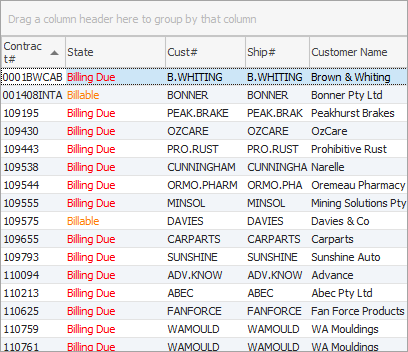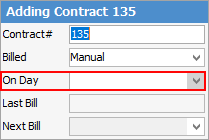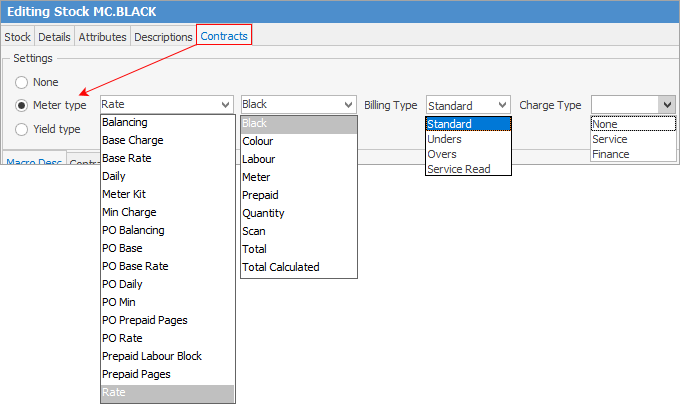
Assets
An Asset is anything supplied to a customer on a do-and-charge basis, ie. a photocopier/printer on a cost per copy basis, for instance. This is what is used to tie everything together in one place.
An Asset keeps track of everything related to a machine, including:
▪The Asset ID – the unique code that identifies this Asset.
▪Who owns the asset (machine) – this links to a customer cardfile.
▪Where the asset is located – this also links to a cardfile.
▪How meter reads are collected – MPS Connectors such as FM Audit, Print Audit, Canon, etc, as well as Happen EKM, via web, email or manual.
▪The Asset's make, model and serial number – this links to an Item.
▪What branch (if using branches), sub-branch or GL department is related to this Asset (if using Branches).
▪The start/finish dates relating to the asset.
▪All related completed (invoiced) jobs – billing jobs, service jobs, etc.
▪All related incomplete jobs – billing jobs, service jobs etc.
A Contract is used for billing, other than service (which is performed via the Asset).
A Contract keeps track of everything related to a machine, including:
▪The Contract ID – the unique code that identifies this contract.
▪Who the customer is – this links to a customer cardfile.
▪The Asset number related to this contract.
▪Where the Asset is located – this links to a cardfile.
▪The Asset's make, model and serial number – this links to an Item.
▪What branch (if using branches), sub-branch or GL Department is related to this Asset.
▪The start/finish dates of the contract.
▪The billing frequency – monthly, quarterly, etc.
▪The billing related dates – last billed, next billed, etc.
▪The contract's meter setup – black, colour, etc.
▪The contract's starting meter reads.
▪The contract's meter billing rates.
▪The contract type – Machine, Master, etc.
▪The contract's price level – the stock price level used for cost of toners, parts, etc.
▪All related (invoiced or not) jobs/purchases.
▪Price Review Date – review date to increase meter charges for billing rates.
▪Comment fields.
Billing Cycles and Lists
Contracts are typically part of a billing cycle, based on their billing frequency. As a contract comes up for billing, based on its Next Bill date, the contract's State will change to Billing Due (coloured red) within a list.

State |
Explanation |
|---|---|
Active |
This means the contract has been billed for the last period and a new bill is not yet due. Text will be coloured orange. |
Billable |
This means that the current date is less than the contract's Next Bill date, but it is within the billing window as set up via Tools > Options > Contract > Machines (Meter Read entry period), however this can be overridden on a connector basis. The billing window allows for contracts to be billed prior to their next bill date, but not too early. Text will be coloured orange. |
Billing Due |
This means that billing is due for this contract. Text will be coloured red. |
Request Sent |
This means a meter read request has been emailed to the customer. Text in the Request Sent column will be coloured green. |
This is all managed via Contract lists. As an example, create a list of all contracts that are within X days of Next Bill Date. Then send meter read requests to these customers, which changes the State to Request Sent. As reads come through, they are entered and billing jobs can be created. The contract is then moved forward to its next billing cycle.
Typically, contracts must always be billed every period, even if a meter read is not received. If a read is not received, an average/estimated or No Read can be billed, or the contract can be skipped for that billing period and moved on to the next.
|
A No Read does not mean that no read will be entered. Jim2 will use the closest available read instead, and this could possibly even be the last billed read. |
|
If Next Bill Due date is set to the 31st of the month, in those months where there are less than 31 days Jim2 will amend the Next Bill Due date to the actual final day of the month. It will then go back to the last day of the next month. Without the On Day setting, it would remain at the same date in the following month, ie. 28 February this month would then move to 28 March next month.
 |
Items
An Item is the asset (machine) make/model. This is set up once per make/model. It defines if the machine is mono (black only) or colour, and what stock (typically toners, consumables, etc.) and meters are related to this specific asset make/model.
An Item called Master should be set up for the master contracts. Ensure to select Black and Colour service meters under the Meter tab in the footer. This also applies to standalone contracts.
|
Set up black and colour stock codes, ensuring the correct meter type is selected under the Contracts tab in the stock code header.
 |
Items are typically related to, and can be easily created from particular stock. For example, I sell asset XYZ, so I have an XYZ stock code. Create an Item based on, and linked to this stock. For older assets, or assets that are not sold but are under contract, create an Item directly.
Stock is used extensively to bill normal things (such as toners) against this machine. It is also used to bill anything meter related, such as pages (number of copies) against the contract. When billing pages, a black page stock code is being billed against a contract as set up in its meter setup.
For instance, a black meter stock is initially set up as a black meter type, and specific billing type under the Contracts tab on the stock record. This prevents using just any stock code when billing pages. This extends to the type of black page being billed (standard, unders, overs, etc.).
There are a number of benefits to using stock to bill pages, including:
▪Meter count, which is the sum of the meter opening balance plus page stock billed (invoiced) minus page stock returned (ie. incorrect meter read fixed via an RFC).
▪Since stock is related to a Stock GL Group, the stock code defines where this appears in income from an accounting point of view.
▪The stock's description as it appears on an invoice can be completely customised using macros (current meter read, pages billed, next bill date, etc.), which are set up on the stock code Contracts tab.
As different stock codes are used for different meters (black, colour, scan, etc.) and for billing groups (standard, unders, overs, minimum volume, minimum charge, etc.), this provides an enormous amount of flexibility from an accounting and reporting point of view.
On the Contracts tab, stock is marked as either Meter or Yield:
▪Meter-related stock is set to a specific meter and meter type, ie. black, base charge, etc.
▪Yield-related stock (or consumables) is used for stock that is considered yieldable, and for what type of yield. For example, a black drum would be marked as yieldable, related to both a drum and the black meter, and have a yield value of, say, 25,000 – the number of copies that can be printed.
Contract Price Level
This is used to drive pricing against a contract for something other than meter billing. This is a Price Level in Jim2. A price level would typically be set up for each contract type. For example, a price level of Toner all $0 means that the machine gets both black and colour toner at $0.00, and a price level of Rental will cover rental meters to allow information to flow though to jobs correctly.
This provides an easy way to set up stock pricing for contracts, and is made even easier by using Jim2's Price Templates feature.
Any job created from a contract will use the contract's price level. If no pricing is available for that price level, Jim2 will use the customer's price level. Therefore, in the example above (Toner all $0), toners and consumables would have this price level, but paper, staples etc. would not, and would be billed at the customer's normal price.
Further information
Managed Print Services Edition
Refurbishing and Replacing Machines

